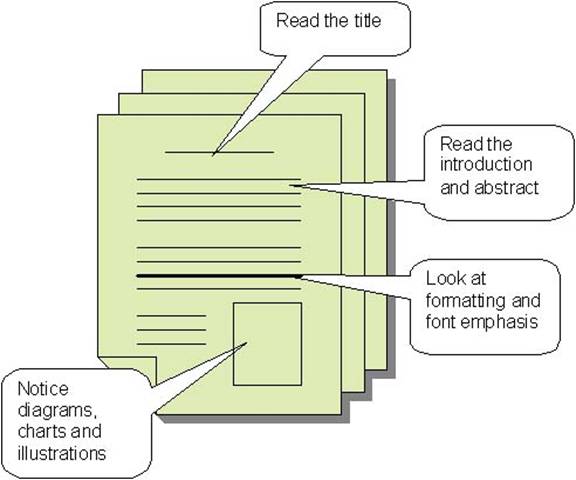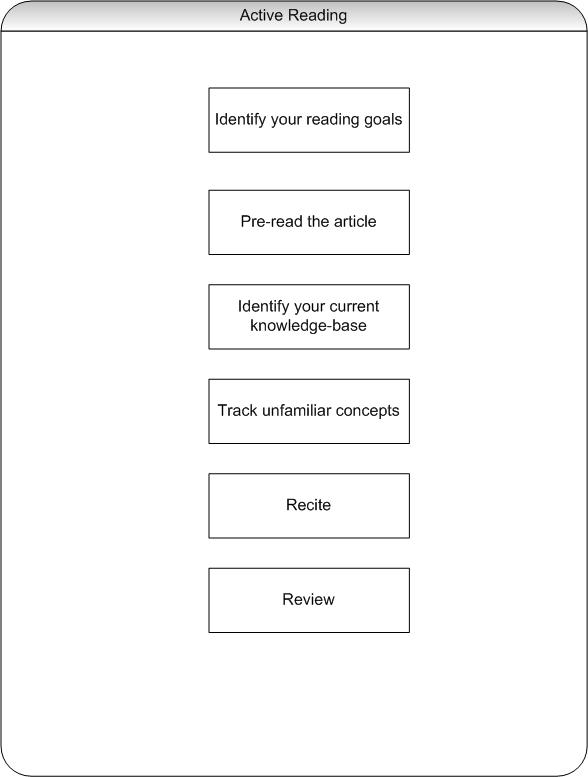Advanced readings skills
Contents
Introduction
In all disciplines, reports of research results will take a specific form, and will present a number of challenges to the novice reader. The level of language, style of presentation, content and vocabulary will often be unfamiliar and will seem lofty. The combination of these factors means that we have to learn a different way of reading in order to make sense of the research article or report. Getting information from academic articles requires an active stance towards the article.
In this unit, we will learn an approach to dense and technical academic reading that will help to make the task both easier and more productive.
The Research Article: Structure
Each discipline will have its own journals, and within those journals, a particular style of presentation.
1
Recall question: What is an academic journal?
An academic journal is a periodical publication which is usually discipline-specific, and quality-controlled. Research articles submited for publication in an academic journal are usually subjected to peer-review by one or several experts in the discipline prior to publication. This review by experts attempts to ensure that the material published is valid, the argument sound and the theoretical basis robust.Check your answer
The way a journal presents an article is different than say a newspaper, a book, or a magazine. Some disciplines use stronger conventions than others with respect to the manner in which articles are presented. Journals reporting the results of experimental research tend to have the highest level of structure.
2
What is experimental research?
Experimental research aims to find out whether a variable has an effect on a particular outcome as well as the direction of that effect.Check your answer
The image above shows a range of structural components of some research articles.
3
What do you know about the components of a research article?
a) A summary containing brief details about the research question, methodology and findings. b) A heading which introduces the article in very general terms. c) A review of related research presented to assist the reader to understand the context of the research question. d) The section of a paper which describes the findings of the research. e) The section of the paper which explains how the study was designed to answer the research question. f) The part of the article which provides some analysis and proposed explanation for the findings. Check your answer
While all articles do not have such headings, most will provide similar structure with or without the headings. A journal article will:
* introduce the topic, either through review of the literature, an introductory section, or a discussion of the background to the author(s) query or interest; * explain how they have chosen to answer or explore their query, whether this be in a clearly identified methodology section, or in a descriptive narrative; * present what they have found out, by a results section, a descriptive narrative, or other illustrative medium; * discuss their findings, the implications these entail, and the investigative areas they open.
4
Obtain three journal articles from three different journals within your discipline, and identify the conventions they use to present research.
Reading for Meaning
Reading a research article is not the same as settling down with a good mystery, where the author puts you in the mood and takes you on a journey where part of the fun is not even knowing where you are going. You should read a research article with intentions. While, on the one hand, every piece of information you read should open doors you might not have thought to knock on before; on the other hand, you approach research articles purposefully. The following sections will show you how you can set goals in academic reading in order to get the most out of an article.
Read with goals
Why do you want to read a particular article?
* Because it is on the recommended reading list? * Because you think it might answer a specific question? * Because other authors have cited it, and you wonder why?
Before you start reading a research article, identify the specific purpose you want to achieve by reading it. To identify this purpose, carefully look at your course outline, your question, or the citations which have pushed you to choose the particular article, and try to identify why you are reading this particular article. It may be that your lecturer has given you explicit clues: "to have a better understanding of the historical underpinnings of the treaty of Waitangi, read so-and-so's article, entitled...." Or that the citations to this piece of writing actually explain the importance of the article: "Patricia Nozay (2002) has provided a theoretical explanation of the framework for collaborative practice in her recent article published in X"
These types of clues then lead you to set a goal for your reading. In these cases the goals would be:
1. obtain understanding of historical underpinnings of the treaty, or 2. obtain a theoretical explanation of the framework for collaborative practice. 3. Answering a specific question that you have identified may have been answered by the article you have at hand.
Whatever the goal might be, you need to establish one so that you can actively engage with the article.
1
Choose an assessment for one of your papers that requires you to write about a particular topic. Locate two articles that you think may be relevant for this assessment. Identify why you choose each article and briefly outline what information you are likely to obtain from each
Check your answer
Pre-read the text
Now that you have a goal to guide you in your reading, take a moment to scan the article, and determine HOW you are going to read it to suit your needs. You know what you need to find out, where does that information lie?
Pre-read one of the articles you chose for the previous activity and predict the following:
How do you know?
The topic of the article
The key themes, words and concepts covered in the article
The method used to answer the researchers' questions
The way you expect it may (or may not) fill your needs (goal).
Engage with the Article - Identify what you know
Let's review:
You have identified why you have chosen to read the article.
You have pre-read the article to get a sense of its content.
Now, you need to get into the article - engage with it, "attack" it- and get as much meaning as possible. Reading is an active process.
1
On a sheet of paper, list the concepts that you already have that can help you to understand this article. You may wish to look at your course notes, or textbook to clarify these concepts before you start reading. Make another list where you can keep track of unfamiliar words and concepts as you read through the articles.
Check your answer
2
Start reading, with your goals in mind. These goals will help you to focus on the things you must understand, and help you to skim through the bits which, while potentially interesting, are not the purpose of your engagement with this article.
Check your answer
Engage with the Article - Identify what you don't know
Let's review:
You have identified why you have chosen to read the article.
You have pre-read the articles to get a sense of its content.
You have listed the concepts you already understand which help you to understand the article.
o Having troubles understanding something? If it's just one word, write it down on your list, and see if you can make meaning of the section without understanding that word. You can look it up later. If you can't make meaning of the section, look it up now. If the problem is greater than just a word, see if you can move on to the next concept without full understanding. If you can't make sense of the next parts without getting a handle on the troublesome area, [identify what concepts within the section you do understand, identify the concepts that you don't understand, and look up that particular concept in a different publication for clarification.
Engage with the Article - Review what you Learn
Let's review:
You have identified why you have chosen to read the article.
You have pre-read the articles to get a sense of its content.
You have listed the concepts you already understand which help you to understand the article.
You have recorded those points you don't understand, and have sought other sources of information to help clarify these.
1
Recite, as you read. As you acquire information, restate it in your own mind, or in writing on your piece of paper. Can you say it in your own words? It will help you to retain the concepts and to concentrate as you read.
Check your answer
2
And finally, review your understanding of the article when you get to the end. See if and how it answered your question, expanded your understanding of the concepts and brought new concepts to your awareness. Put this review into writing with a brief paragraph summarising your findings.
Check your answer
Summary of Active Reading
| Work in progress, expect frequent changes. Help and feedback is welcome. See discussion page. |


